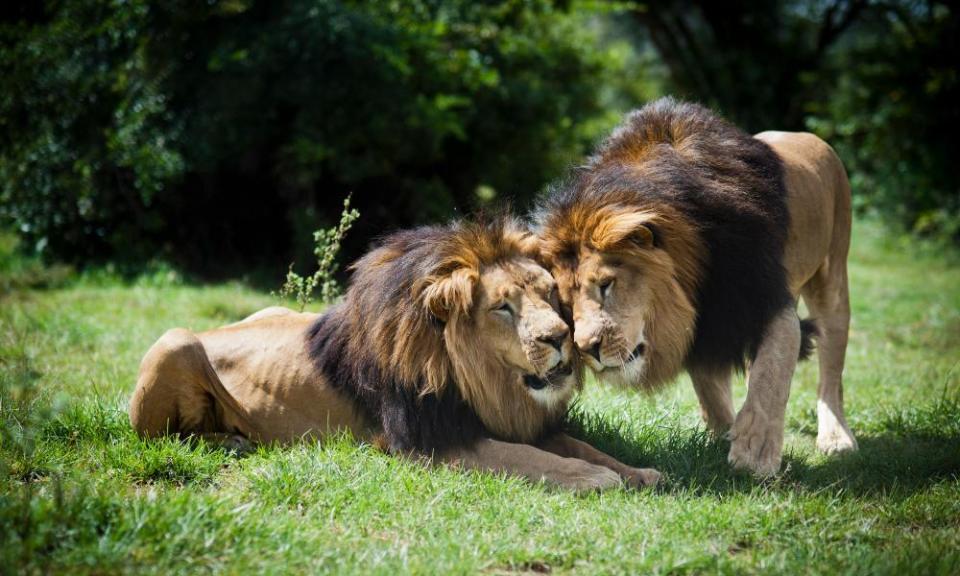‘Humans everywhere’: lions cling on in Ethiopia’s last patches of wilderness

Standing in a patch of damp forest, a clump of moss in one hand, Siraj Hussein applies the last touches to a camera trap. He explains why his chosen tree is in an ideal spot: it is in a clearing, which gives the sensors a good view, and lion droppings have been found nearby. “So far, I haven’t captured a lion on my camera, but I’m optimistic,” he says.
Siraj is gathering data on the behaviour of the lions in the Kafa biosphere reserve, in south-west Ethiopia – one of the country’s last few tracts of natural forest – as part of a new project by the Nature and Biodiversity Conservation Union (Nabu), a German environmental group.
Researchers believe there are about 25 lions in this area, but little is known about them. It is not clear if they are resident year-round or just migrate through. One thing, however, is certain: their numbers are declining. “Twenty years ago, you would always see lions lying in the road,” says Asaye Alemayehu, who runs the Nabu project. “Now that is almost unheard of.”

Ethiopia’s lions are known for their distinctive black manes. They occupy a prominent position in national culture: their image adorns the currency, while Haile Selassie, Ethiopia’s last emperor, called himself the “lion of Judah”.
However, like Ethiopia’s other wildlife, they have been pushed to the brink by decades of neglect and habitat destruction, much of it driven by a rapidly expanding human population – the second biggest in Africa (after Nigeria) at more than 120 million. Forest once covered 40% of Ethiopia. Today it covers only about 15%, according to the World Bank.
“It’s not just the lions that are under pressure, it’s biodiversity in general,” says Asaye.
There are about 1,100 lions clinging on in Ethiopia’s last remaining pockets of wilderness, according to a study published in 2021. They often encounter farmers, whose livestock they prey on. Human-wildlife conflict is the main factor driving their decline, says Hans Bauer, a zoologist at the University of Oxford and a co-author of the study.
Conservation is hamstrung by a lack of funding. Ethiopia was among the first countries in Africa to establish national parks, but most are in a poor state, without good roads or other infrastructure. Lacking the vehicles and fuel needed for regular patrols, government-employed rangers struggle to prevent well armed herders from grazing their cattle in protected areas.
Bauer contrasts the precarious existence of Ethiopia’s lions to that of the thriving population in neighbouring Kenya, where lions play a starring role in the lucrative wildlife tourism sector and where numbers grew from about 2,000 lions in 2010 to nearly 2,500 in 2021. Recognising their economic value, Kenya has invested heavily in its national parks.
There are humans everywhere and there are no habitats that are fully protected or where prey is present at high levels
Hans Bauer, zoologist
In Kenya, “lions have space, they are protected and live in high densities with ecological potential”, says Bauer. “That doesn’t exist in Ethiopia – there are humans everywhere and there are no habitats that are fully protected or where prey is present at high levels.”
The Kafa biosphere is better managed than most of Ethiopia’s national parks, largely thanks to backing from Nabu, which runs reforestation and other schemes. But even here, the natural habitat is under threat. Farms rub up against protected areas of forest and in recent years large tracts have been cleared to make way for commercial tea and coffee plantations.
On a hillside in Kafa, a group of farmers complain that lions regularly take their livestock. Each cow can cost a year’s salary, but the government does not compensate them. One man shows scars on his back from a lion attack several years ago. Another recalls how a lion once broke down the door of his hut and grabbed a goat while he was sleeping inside.
Many farmers want the lions to be relocated away from their farms. “If there were no lions, it would be better,” says Busho Woldesaki, who has lost three cattle to lion attacks in the past two years. “Our animals can’t graze freely because we fear the lions.”
It is rare for people to kill lions in Kafa, where they are respected. In other parts of Ethiopia, however, herders often hunt lions down in retaliation for livestock attacks.
Fikirte Gebresenbet, a lion expert at the University of New Hampshire, highlights the need for more research before attacks such as these can be curbed. “Lions are under serious threat, but we don’t really have data on their distribution, and if you don’t have that baseline data, you can’t do any conservation work. We have to determine where we have viable populations, otherwise you are just throwing resources down the drain … In Kenya there are a lot of ecologists studying lions. They know them by name, by their whiskers. That’s the level of detail they are working with. In Ethiopia, we don’t have that.”
For now, Nabu’s project in Kafa is focused on building a clearer picture of the local lions. Siraj and other rangers gather information on lion sightings from farmers, but these days he sets up his camera traps in secret – he only has one left after two were stolen.
Related: Florence and her cubs give hope that west African lion can come roaring back
Despite talk from the government of developing tourism, Kenyan-style wildlife conservation “is not a serious option” in Ethiopia, says Bauer. “The pressures on the land are too high.” But other steps could be taken to minimise conflict with humans, such as restocking prey populations and providing compensation.
“There’s a whole toolbox of activities to draw upon, but first we need more research,” says Bauer.
Budget constraints mean the Ethiopian Wildlife Conservation Authority (EWCA) prioritises endemic species such as the Ethiopian wolf and the walia ibex, says Fekede Regassa, its head of research. If these species were lost, it would mean extinction, whereas lions would persist elsewhere.
Fekede says more funding would make protecting Ethiopia’s lions possible, but “if things continue as they are, with deforestation and other human factors, we will lose the lions. No question.”
Find more age of extinction coverage here, and follow biodiversity reporters Phoebe Weston and Patrick Greenfield on Twitter for all the latest news and features

 Yahoo Sports
Yahoo Sports 